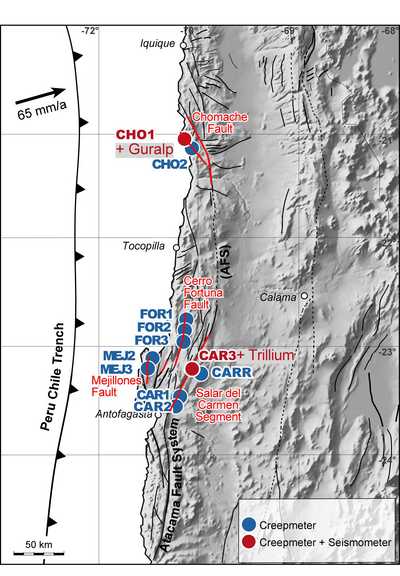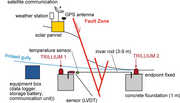Creepmeter at IPOC
A creepmeter is an instrument that monitors surface displacement of an active fault. The Creepmeter Array in N-Chile, which is part of the Integrated Plate Boundary Observatory in Chile (IPOC) is designed to record continuous or episodic displacement as well as triggered displacement events along the trench parallel Atacama Fault System. The main goal of the study is to record a continuous time-series of displacement across the target faults to understand the mechanism of strain accumulation along crustal faults located in the Chilean Forearc above a highly active subduction zone interface. The first pilot instrument was installed in 2007, after the Tocopilla earthquake on the Mejillones Peninsula. Today 11 instruments are continuously monitoring displacement accumulation across the 4 target faults, three of the instruments are collocated with broadband seismometers for signal correlation. One of the instruments is designated as reference station which is not installed across a fault but under the same overall conditions.
Instrumentation
All the installed instruments use 12 mm thick invar rods as length standards, which are firmly attached to a concrete foundation on one side of the fault and pass through a PVC pipe to the far side of the fault. The creepmeters are buried at a depth of 30 - 70 cm, in order to increase the signal-to-noise ratio. We use a LVDT (linear variable differential transformer) with a linear range of 50mm to monitor the relative displacement of the free end of the rod relative to the fixation point. Displacement is converted to voltage change and stored on a data logger with a sampling rate of 2/min. The temperature at the rod is also continuously measured with the same sampling rate but we store only an average of 10 min to decrease the data volume and correct the thermal expansion and contraction of the length standard. The length of the instrument is dependent on the geometry at each site and ranges between 2 and 9 m. One station per target fault is also equipped with a weather station to control effects of humidity and air pressure changes. The time of each data logger is synchronised via GPS automatically. All instruments are equipped with an Inmarsat/BGAN satellite link and data is sent to the GFZ ftp server every third day.
Collocated with three of the creepmeters, we operate broadband seismometers to investigate triggered displacement events. The CHO1 site is equipped with seismometer CHOM (Guralp CMG-3ESP, sampling frequency 100Hz) since 2011 (collaboration with Monika Sobiesiak). CAR3 is equipped with a Trillium seismometer (sampling frequency 100 Hz) since 2014. MEJ3 is equipped with a Trillium seismometer (sampling frequency 100Hz) since 2017 (collaboration with Pablo Salazar, UCN).
Data
The IPOC Creep data are available upon request via https://doi.org/10.5880/GFZ.1.1.2017.002.
Please cite them as:
Victor, Pia; Ziegenhagen, Thomas; Oncken, Onno; Gonzalez, Gabriel (2017): IPOC Creep. GFZ Data Services. doi.org/10.5880/GFZ.4.1.2017.002
Partners and People
People involved: Pia Victor (PI), Thomas Ziegenhagen (GFZ, chief technician), Gabriel Gonzalez (UCN), Pablo Salazar (UCN), Monika Sobiesiak (Universität Kiel), Onno Oncken (GFZ)
Students:
- Julia Berger (2020 – ongoing)
- Ariane Müting (student assistant, 2017 -2020)
- Matthias Kemter (student assistant and master thesis, 2015-2017)
- Christoph Bach (diploma thesis 2010)
Partner institutions: Universidad Católica del Norte, GFZ German Resarch Centre for Geosciences
Selected Publications
Victor, P., Oncken, O., Sobiesiak, M., Kemter, M., Gonzalez, G., Ziegenhagen, T. (2018): Dynamic triggering of shallow slip on forearc faults constrained by monitoring surface displacement with the IPOC Creepmeter Array. - Earth and Planetary Science Letters, 502, 57-73. https://doi.org/10.1016/j.epsl.2018.08.046
Gassenmeier, M., C. Sens-Schönfelder, T. Eulenfeld, M. Bartsch, P. Victor, F. J. Tilmann, and M. Korn (2016), Field observations of seismic velocity changes caused by shaking-induced damage and healing due to mesoscopic nonlinearity, Geophysical Journal International, 204(3), 1490–1502, https://doi.org/10.1093/gji/ggv529
Victor, P., Kemter, M., Ewiak, O., Ziegenhagen, T., Oncken, O., Gonzalez, G. (2016): Unterschätzte Unbekannte – Aktive Störungen in der Oberplatte großer Subduktionssysteme. - System Erde, 6, 2, pp. 30—35. http://doi.org/10.2312/GFZ.syserde.06.02.5
Shirzaei, M., Bürgmann, R., Oncken, O., Walter, T., Victor, P., Ewiak, O. (2012): Response of forearc crustal faults to the megathrust earthquake cycle: InSAR evidence from Mejillones Peninsula, Northern Chile. Earth and Planetary Science Letters, 333-334, 157-164, https://doi.org/10.1016/j.epsl.2012.04.001




